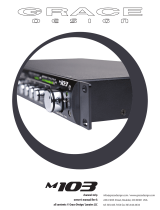
17
FRANÇAIS
Image stéréo et glissement de l’image stéréo
Avant de calibrer l’appareil pour une utilisation stéréo, il est important de savoir ce qu’on entend par glissement de l’image stéréo et
pourquoi on souhaite généralement l’éviter. Contrairement à l’idée reçue, l’image stéréo ne glisse pas pour des raisons de déséquilibre
gauche/droite ni de transitoires présentes uniquement dans l’un des côtés du signal stéréo, qui sont des problèmes différents qu’il faut
éviter plus en amont du processus de production. Dans le cadre de notre discussion, le glissement de l’image stéréo apparaît quand
les canaux d’un processeur de dynamique se comportent différemment de part et d’autre du champ stéréo. Cela peut détruire l’image
stéréo qui, pour rester fiable, nécessite que les deux canaux d’un compresseur stéréo agissent à l’identique quelle que soit la source
de signal. Avec deux WA-2A, vous pourrez faire essentiellement trois choses différentes :
1. Les deux WA-2A peuvent fonctionner de façon autonome (Stand-Alone).
2. Les deux WA-2A peuvent fonctionner en couple stéréo, auquel cas ils se partagent un seul signal de chaîne latérale
sommé ou recalibré.
3. Les deux WA-2A peuvent fonctionner comme un appareil stéréo qui compresserait deux signaux audio différents sur la
base du signal de la chaîne latérale d’un seul WA-2A (ducking).
Calibrage pour l’utilisation en stéréo
1. Calibrez le VU-mètre des deux appareils. Vérifiez qu’aucun signal audio n’alimente l’entrée, placez le sélecteur Meter sur Gain
Reduction et réglez le VU-mètre sur 0 dB avec le bouton Meter Adjust du panneau arrière.
2. Raccordez le connecteur Stereo Link des deux appareils avec un câble symétrique monté en jacks trois points (pointe, bague, tige).
Le câble doit être court, l’idéal étant qu’il ne dépasse pas 60 cm.
3. Les deux boutons Stereo Link doivent être en position Stand-Alone. Grâce au câble symétrique qui relie les deux WA-2A, les
chaînes latérales se partagent une tension de commande commune et le réglage Stereo Link permet de compenser très précisément
les éventuelles différences de réponse entre les deux appareils. Quand on tourne le bouton vers la droite, le niveau de la chaîne
latérale baisse dans l’appareil réglé et augmente dans l’autre appareil. Si les côtés du signal stéréo qui alimente les deux WA-
2A sont très proches par nature, les ajustements à réaliser seront légers voire superflus. Il est conseillé de prendre la réduction de
gain réglée en mode Stand-Alone (câble de couplage débranché) comme référence pour la réduction de gain en mode stéréo,
naturellement en utilisant le même signal source dans les deux modes. Si la réduction de gain est plus forte en mode stéréo qu’en
mode Stand-Alone (câble de couplage débranché), utilisez le bouton Stereo Link pour réduire le niveau de la chaîne latérale.
Le signal de la chaîne latérale est généré quand on augmente le réglage Peak Reduction. Avec une source stéréo, on voudra
généralement que les deux WA-2A aient le même niveau de réduction (Peak Reduction) pour que les signaux droit et gauche soient
représentés à parts égales dans la chaîne latérale. On peut obtenir un effet de type « ducking » en réglant la réduction de gain sur
un seul WA-2A. Dans ce cas, les deux compresseurs réagissent uniquement au signal de la chaîne latérale de l’appareil qui a été
réglé. Dans cette configuration, l’un des WA-2A est considéré comme maître tandis que l’autre est esclave en ce sens qu’il suit le
premier. Ainsi, les deux appareils réagissent uniquement aux transitoires du WA-2A maître. En utilisation stéréo normale, il n’y a ni
maître ni esclave car les signaux de la chaîne latérale des deux appareils sont mélangés dans les mêmes proportions. Ainsi, les deux
WA-2A réagissent uniformément à l’apparition d’une crête, qu’elle soit dans le canal gauche ou droit. C’est la configuration idéale
pour traiter un bus stéréo.
4. Alimentez les deux appareils avec un signal de test ou de la musique puis tournez Peak Reduction
vers la droite sur les deux WA-2A jusqu’à ce que les VU-mètres indiquent une réduction de gain. Si les
VU-mètres ont été calibrés et le réglage Peak Reduction est identique sur les deux appareils, les aiguilles doivent normalement
avoir des comportements très proches. S’il y a un écart visible de réduction de gain, utilisez le réglage Stereo Link pour
compenser le déséquilibre.

























